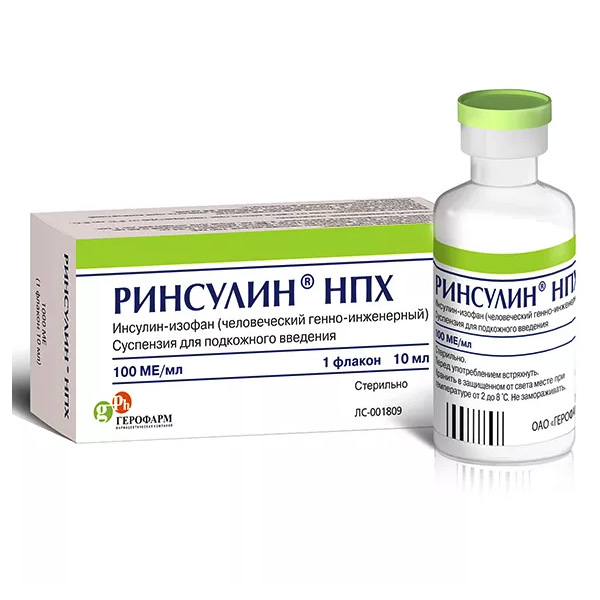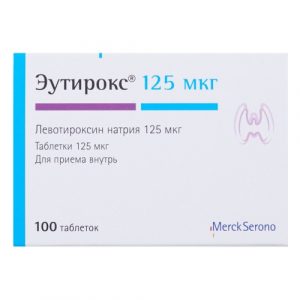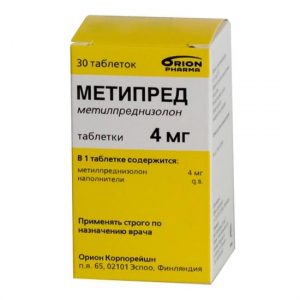Description
Latin name
Rinsulin NPH suspension for p / dermal introduction. 100 IU / ml bottle 10 ml
Release form
Suspension for subcutaneous administration.
Packing
Bottle of 10 ml.
Pharmacological action
Pharmacotherapeutic group
Hypoglycemic agent, medium-duration insulin
Code ATC-A10AC01.
Pharmacological properties
Pharmacodynamics.
Rinsulin ® NPH is a human insulin obtained using recombinant DNA technology. Medium duration insulin. It interacts with a specific receptor on the outer cytoplasmic membrane of cells and forms an insulin-receptor complex that stimulates intracellular processes, including the synthesis of a number of key enzymes (hexokinase, pyruvate kinase, glycogen synthase, etc.). A decrease in blood glucose is caused by an increase in its intracellular transport, increased absorption and assimilation of tissues by stimulation of lipogenesis, glycogenesis, a decrease in the rate of glucose production by the liver, etc.
The duration of action of insulin preparations is mainly due to the rate of absorption, which depends on several factors (for example, dose , method and place of administration), in connection with which the profile of insulin action is subject to significant fluctuations, both in different people and in the same person.
On average after subcutaneous administration of Rinsulin ® NPH on
The duration of action of insulin preparations is mainly determined by the absorption rate, which depends on several factors (for example, on the dose, method and place of administration), and therefore the profile of action of insulin is subject to significant fluctuations, both in different people and in one same person.
On average after subcutaneous administration of Rinsulin ® NPH on
The duration of action of insulin preparations is mainly determined by the absorption rate, which depends on several factors (for example, on the dose, method and place of administration), and therefore the profile of action of insulin is subject to significant fluctuations, both in different people and in one same person.
On average after subcutaneous administration of Rinsulin ® NPH onbegins to act after 1.5 hours, the maximum effect develops between 4 and 12 hours, the duration of action is up to 24 hours.
Pharmacokinetics
The completeness of absorption and the onset of the effect of insulin depends on the injection site (abdomen, thigh, buttocks), dose (volume of injected insulin), concentration of insulin in the drug, etc. It is distributed unevenly across the placental barrier and into breast milk. It is destroyed by insulinase mainly in the liver and kidneys. It is excreted by the kidneys (30-80%).
Indications
Type 1 diabetes mellitus.
Sugar. diabetes type 2 stage of resistance to oral hypoglycemic agents, partial resistance to these drugs (during combination therapy), intercurrent diseases.
Type 2 diabetes in pregnant women.
Contraindications
Increased individual sensitivity to insulin or any of the components of the drug.
Hypoglycemia.
Use during pregnancy and lactation
There are no restrictions on the treatment of diabetes mellitus with insulin during pregnancy, because insulin does not cross the placental barrier. When planning pregnancy and during it, it is necessary to intensify the treatment of diabetes.
Insulin demand usually decreases in the first trimester of pregnancy and gradually increases in the second and third trimesters. During and immediately after birth, insulin requirements may decrease dramatically. Shortly after birth, the need for insulin quickly returns to the level that was before pregnancy.
There are no restrictions on the treatment of diabetes mellitus with insulin during breastfeeding. However, it may be necessary to reduce the dose of insulin, therefore, careful monitoring for several months is necessary before stabilizing the need for insulin.
Composition of
1 ml of the preparation contains:
active substance:
human insulin 100 ME
excipients:
protamine sulfate 0.34 mg,
metacresol 1.6 mg,
crystalline phenol 0.65 mg,
glycerol 16 mg,
sodium hydrogen phosphate dihydrate 2.25 mg,
water for injection up to 1 ml.
Dosage and administration
The drug is intended for subcutaneous administration. The dose of the drug is determined by the doctor individually in each case, based on the concentration of glucose in the blood. On average, the daily dose of the drug ranges from 0.5 to 1 IU / kg body weight (depending on the individual characteristics of the patient and the concentration of blood glucose).
Intravenous administration of the drug Rinsulin ® NPH is contraindicated. The temperature of the injected insulin should correspond to room temperature.
The drug is usually administered subcutaneously in the thigh. Injections can also be done in the anterior abdominal wall, buttock or shoulder region in the projection of the deltoid muscle. It is necessary to change the injection site within the anatomical region in order to prevent the development of lipodystrophy. With subcutaneous administration of insulin, caution is required, so as not to enter the blood vessel during injection. After the injection, the injection site should not be massaged. Patients should be trained in the proper use of the insulin delivery device.
Rinsulin ® NPH cartridges before use should be rolled between the palms in a horizontal position 10 times and shaken to resuspend the insulin until it becomes a uniform turbid liquid or milk. Foam should not be allowed to occur, which could interfere with the correct dose. Cartridges should be checked carefully. Do not use insulin if it contains flakes after mixing, if solid white particles adhere to the bottom or walls of the cartridge, giving it the appearance of a frozen one. The cartridge device does not allow mixing their contents with other insulins directly in the cartridge itself. Cartridges are not intended to be refilled.
When using cartridges, the manufacturer’s instructions for refilling the cartridge into the syringe pen and attaching the needle should be followed. The drug should be administered in accordance with the instructions of the manufacturer of the syringe pen.
After insertion, it is necessary to unscrew the needle using the outer cap of the needle and immediately destroy it safely. Removing the needle immediately after injection ensures sterility, prevents leakage, air ingress and possible clogging of the needle. Then put the cap on the handle.
Needles should not be reused.
Store the drug in use at room temperature (from 15 to 25 ° C) for no more than 28 days, protect from direct sunlight and heat.
Side effects of
Due to the effect on carbohydrate metabolism: hypoglycemic conditions (pallor of the skin, increased sweating, palpitations, tremors, chills, hunger, agitation, paresthesia of the oral mucosa, weakness, headache, dizziness, dizziness) . Severe hypoglycemia can lead to the development of hypoglycemic coma.
Allergic reactions: skin rash, Quincke’s edema, anaphylactic shock.
Local reactions: hyperemia, – swelling and itching at the injection site, with prolonged use of lipodystrophy at the injection site.
Other: edema, transient decrease in visual acuity (usually at the beginning of therapy).
If the patient has noted the development of hypoglycemia or has had an episode of loss of consciousness, he should immediately inform the doctor.
If any other side effects are not described above, the patient should also consult a doctor.
Drug Interaction
There are a number of drugs that affect your insulin requirement.
Hypohlykemycheskoe action Insulin usylyvayut oral hypohlykemycheskye Preparations, ynhybytor oxidase, ynhybytor angiotensin-converting enzyme ynhybytor karboanhydraz , neselektyvn e beta-blockers, bromocriptine, octreotide, sulfanylamyd , anabolic steroyd , tetratsyklyn , klofybrat, ketoconazole, mebendazole, pyridoxine, theophylline, tsiklofosfamida, fenfluramyn, Preparations lithium, preparations containing ethanol.
The hypoglycemic action of insulin is weakened by glucagon, somatropin, estrogens, oral contraceptives, glucocorticosteroids, iodine-containing thyroid hormones, thiazide diuretics, loop diuretics, heparin, tricyclic antidepressants, sympathomimetics, danazol, clonidine, epinephrine, H1-histamine receptor blockers, slow calcium channel blockers, diazoxide, morphine, phenytoin, nicotine. Under the influence of reserpine and salicylates, both attenuation and intensification of the drug are possible.
Overdose
Hypoglycemic conditions may develop with an overdose of the drug. The initial symptoms of a hypoglycemic condition are sudden sweating, palpitations, tremors, hunger, agitation, paraesthesia in the mouth, pallor, headache. In severe cases of overdose may develop hypoglycemic coma.
Treatment: The patient can eliminate mild hypoglycemia by taking sugars or carbohydrate-rich foods by himself. In severe cases, 20 to 40 ml of 40% glucose solution is administered intravenously, 1 mg of glucagon intramuscularly.
Storage conditions
In the dark place at a temperature of + 2 ° C to 4-8 ° C.
Avoid freezing.
Expiration
2 years.
Deystvuyuschee substances
Insulin-yzofan chelovecheskyy genetically Inzhenernyi
Sardlkp pharmacy terms for prescription
dosage form
dosage form
injection solution




